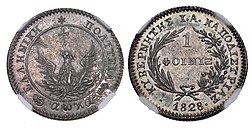
Back Fènix (moneda) Catalan Phönix (Währung) German Φοίνιξ (χρηματική μονάδα) Greek Fénix griego Spanish Fööniks (rahaühik) Estonian Phénix (monnaie grecque) French Fénix (moeda) Galician פיניקס יווני HE Fenice (valuta) Italian Feniksas (pinigai) Lithuanian
| φοίνιξ (Greek) | |
|---|---|
 Silver one-phoenix coin, minted in Aegina by Count Ioannis Kapodistrias. Dated 1828. Obverse: phoenix rising from the ashes below a cross, symbol of the newly reborn Orthodox Christian Greek state, inscription 'ΕΛΛΗΝΙΚΗ ΠΟΛΙΤΕΙΑ' ('Hellenic State'). The letters αωκα represent 1821, the date of the Greek Declaration of Independence, in the Ancient Greek numeral system. The small anchor was the Aegina mint mark. Reverse: denomination '1 ΦΟΙΝΙΞ' ( '1 phoenix') inscription: 'ΚΥΒΕΡΝΗΤΗΣ Ι.Α. ΚΑΠΟΔΙΣΤΡΙΑΣ' ('Governor I.A. Kapodistrias') | |
| Denominations | |
| Subunit | |
| 1⁄100 | Lepton (Λεπτόν) |
| Plural | |
| Lepton (Λεπτόν) | Lepta (Λεπτά) |
| Demographics | |
| Date of introduction | 1828 |
| Replaced by | Drachma |
| User(s) | First Hellenic Republic |
| Issuance | |
| Mint | Aegina National Mint |
| This infobox shows the latest status before this currency was rendered obsolete. | |


The phoenix (Greek: φοίνιξ, foinix) was the first currency of the modern Greek state. It was introduced in 1828 by Governor Count Ioannis Kapodistrias and was subdivided into 100 lepta. The name was that of the mythical phoenix bird and was meant to symbolize the rebirth of Greece during the still ongoing Greek War of Independence. The phoenix replaced the Ottoman kuruş (called grosi γρόσι, plural γρόσια grosia by the Greeks) at a rate of 6 phoenixes = 1 kuruş.